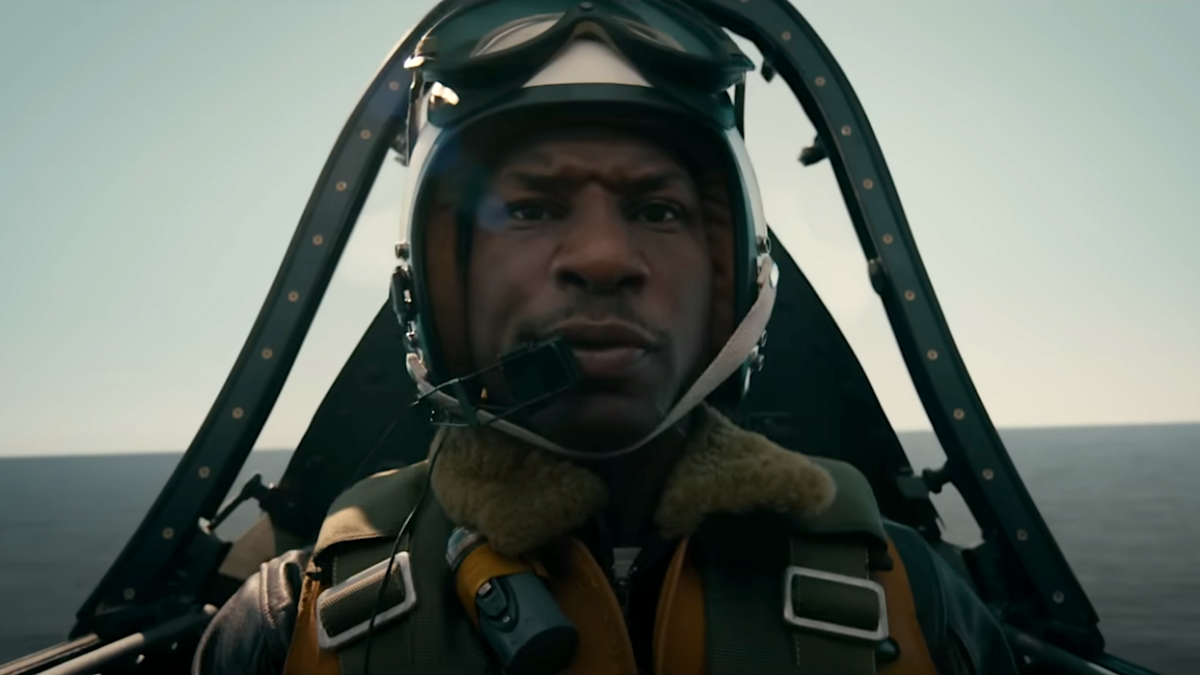Following the sky-high box-office numbers of “Top Gun: Maverick,” anyone who glanced at the movie trailer for “Devotion” — a true story of heroic U.S. Naval pilots, currently in theaters — probably thought producers were trying to cash in on the craze.
This historical film has been in the works for over six years, however, starting shortly after the book, “Devotion: An Epic Story of Heroism, Friendship, and Sacrifice,” began to make waves. It recounts how two long-overlooked pilots led a mission that turned the tide in the Korean War’s most brutal battle.
“That entire war has been woefully forgotten,” author Adam Makos told me in a phone interview. “The last major Korean War movie was ‘Pork Chop Hill’ starring Gregory Peck, released in 1959 — over 60 years ago. And Hollywood hasn’t gone there since.”
Diverse talent came together to produce “Devotion.” Actor Glen Powell, known for “Hidden Figures” and recently as one of the “Top Gun” pilots, read the book and ultimately met real-life pilot Tom Hudner to secure the film rights prior to the decorated veteran’s death in 2017.
Then there’s film director J.D. Dillard, whose father was only the second African American pilot in the Navy’s Blue Angels squadron.
Dillard proved to be the ideal pick to helm the story of Hudner and Jesse Brown, the first black aviator in Naval history. Brown is played by actor Jonathan Majors, who will soon be seen in “Creed III” and multiple “Avengers” films as baddie Kang the Conqueror.
When Authenticity Is Costly
The author, who spent months with Hudner and Brown’s family members for research, said interacting with them left him in awe even more so than meeting Hollywood stars.
“If we’re to become better people as Americans, to grow as a country and culture, we have to remember our heroes,” said Makos. “A culture that forgets its heroes has no future.”
Such a rare ethos of honor permeates the film — including with another key player, aerial coordinator Kevin LaRosa Jr., known for deploying the CineJet system on “Top Gun: Maverick” for maximum in-flight realism. Here they took it a step further, restoring four authentic F4U Corsairs for their lead pilots to fly.
Makos, who has also authored three books on key World War II figures, was thrilled. “The moment I saw those planes coming into the hangar, I knew we were going to have something very serious, real, and visceral,” he said. “They could’ve done one or two planes and the others digitally, but they didn’t.”
He also points out that the visuals look so good some will assume it’s all CGI. “That Corsair really is ripping down the river, with the prop tips at five feet above the waves. Sure, a little bit of CGI comes in from the scenery and the bullets being fired at him. But the scene is actually happening.”
Prelude to Heroism
The climax of the story is set in November 1950, at a critical flash point in the conflict. But prior to taking viewers into the trenches and above the mountains of North Korea, viewers are introduced to a half-dozen Naval pilots serving at Quonset Point Air Base in Rhode Island.
World War II looms large. Many of the 20-something pilots, like Hudner, joined the military following the attack on Pearl Harbor and the subsequent wave of national unity.
Then the war ended a few months prior to his graduation from flight school. By early 1950 the fleet is largely mothballed, and pilots are doing post-war busy work.
These early scenes provide insight into what drives Brown, who faced the same grueling challenges as any Naval aviator — and then some. Brown confides in his wingman Hudner: “A slap on my wrist, it’s not the same as a slap on yours.”
Strength to Overcome
“Jesse Brown ultimately loved America,” Makos told me. “He wanted to fight for a country that made him sit in the back of the bus because he loved the idea of what it can be.”
In the years following the WWII heroics of the Tuskegee Airmen, the U.S. Navy began to take steps toward racial integration — starting with Brown. On base, some fellow pilots refer to him using racial slurs. Later in the film, Brown is called a “circus act” when a Life Magazine reporter interviews him.
Actor Jonathan Majors draws out Brown’s zeal beyond simply long-suffering. In a memorable scene where Brown is alone in a locker room, he gazes into a mirror and repeats insults that had been spoken to him. “He actually did that,” said historian Makos, who interviewed Brown’s now-elderly brothers Fletcher and Lura for his book.
“They had one mirror in their house,” explained Makos. “As a young kid, Jesse would look in the mirror and say these insults until they didn’t hurt anymore. He did that to defuse the power of those words — until the point where he could be called anything, and it just didn’t impact him.”
Years later, Brown’s character and determination won over his prejudiced critics. That was especially clear once crisis hit. The commander of Strike Fighter Squadron 32, decorated WWII pilot Richard “Dick” Cevoli, briefs his men that they’ll be heading to Korea.
Action-Packed Acts of Valor
Much of the film’s crucial second act — including several edge-of-your-seat training sequences — occurs on board and in the skies above naval aircraft carrier USS Leyte. When Makos arrived in Georgia to visit the film set, including appearing in a brief cameo, the scale of their recreation shocked him.
“Near this small airfield in Savannah, they literally built the superstructure of an aircraft carrier from the ground up — to scale,” said Makos. “Everything from the gun mounts to the radar domes, to the bridge with the windows, the whole thing was made out of steel.”
The film’s stunning finale, which includes air, land, and sea forces working in tandem, depends on some high-level production work to recreate the Hagaru-ri base camp in North Korea.
For all the spectacle, “Devotion” is a story of two men learning to be more than a “squadron of one.” Having interviewed countless veterans, Makos says he has seen something remarkable in them.
“I think patriotism is a great unifier, and we realize it usually when our country is in trouble,” he said. “That’s when we’re suddenly patriotic, and we’re all together.”
Rated PG-13 for strong language, some war action/violence, and smoking, “Devotion” is currently playing in theaters nationwide.









